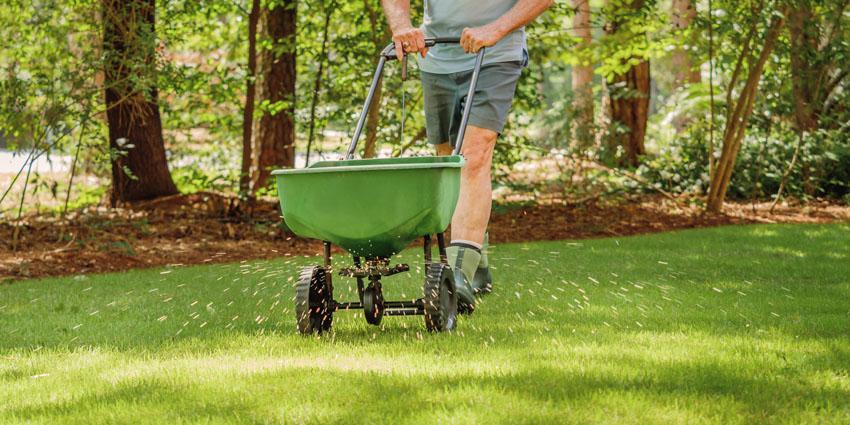
Created By
Matt Adams
Updated On
- January 20, 2025
Get FREE Exclusive Access
Keep your lawn pristine with exclusive tips, offers and insights that I only share with my private subscribers.
Latest Posts
How & When to overseed a UK lawn – Spring vs Autumn
- By Matt Adams
- January 20, 2025
Jump to
Get FREE Exclusive Access
Keep your lawn pristine with exclusive tips, offers and insights that I only share with my private subscribers.
When a lawn looks stressed after the Winter it’s easy to think it just can’t be revived. Don’t worry though, there’s a great chance that it can.
Whether you’ve scarified or done a bit of aerating, overseeding the lawn is by far the best option to get it looking thick and lush again.
So, in this article, I’m going through the steps on how to overseed your lawn. Whether doing it in the Spring, Summer or Autumn, you’ll find out how to sort it after scarifying and aerating.
A heads up that our Full Lawn Renovation Kit also includes full instructions alpongside the exact products for completing an overseed of your lawn.
-
Spring Lawn Renovation & Overseeding Kit
£29.00 – £97.00
What’s more, find out whether you need to apply a top dressing too.
In the article, I’ll answer some of the most common questions as well as the end-to-end process.
Let’s start with a summary overview then I’ll explain when and how often.
VIDEO : Overseeding my own UK Lawn in Spring
You are currently viewing a placeholder content from Default. To access the actual content, click the button below. Please note that doing so will share data with third-party providers.
More InformationINFOGRAPHIC : A simple summary of overseeding steps

When & how often should you overseed the lawn
On most websites, you will read the best time to overseed is somewhere between Spring and Autumn. I highly recommend doing it in both Spring and Autumn. If you miss the Spring one, then it’s fine to do it in the Summer, just make sure you keep the ground moist if the weather is warm, while the seed germinates.
In England, it’s usually not a problem finding a wet week to sow your grass seed during the Summer.
If you’re planning on top dressing your lawn, more on this below, then it’s best to do it after you overseed. That’s because you can be sure the new seed will hit the soil.
Ultimately by seeding little and often, you will keep the grass more prominent and it will be able to fight off invasion from other weeds and disease.
Products For Overseeding
-
Premium Shade Grass Seed
- £7.50 – £120.00
- Rated 4.88 out of 5
- Select options This product has multiple variants. The options may be chosen on the product page
-
Signature Spring & Summer Lawn Feed
- £0.14 - £0.69 / per m2
- Rated 5.00 out of 5
- Select options
STEB-BY-STEP : How to overseed in Spring & Autumn
Whether you’re doing it in Spring or Autumn, the method is by and large the same both times. It just depends on how bad the lawn is at your starting point.
For example, in the past, I’ve scarified twice in March and April, prior to over seeding and then used a 70/30 sand to soil top dressing before overseeding. But, all that isn’t essential if your lawn is already in a half decent shape.
Here are the key steps to take when overseeding the ground in Spring.
Preparing the ground
1. Kill off the moss
You might have been keeping your lawn in good ‘nick’ and don’t have to worry about moss at all. If that’s you, then go straight to the next step. If you’ve got moss, then you’ve got a slightly longer journey than the rest.
I’ve written a full post about how to get rid of moss, so have a read of that too.
Any how, I always recommend using a specific moss killer if you have a problem with moss as opposed to any 4-in-1 product. It just works better, and will hit the moss right at the source.
You can find our fast acting moss killer here. Using this product, you will literally see the moss turn black within a few hours and it will be ready to be scarified after a couple of days
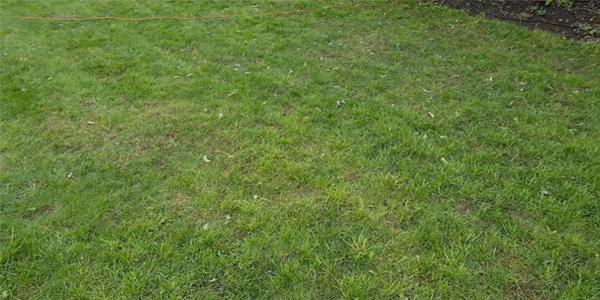
2. Scarify the area
Scarifying is super important to allow oxygen and feed products to get right through to the soil and not get blocked off by what’s known as thatch.
I’ve also written a full post on scarifying the lawn, so have a read of that to find out the best way to go about it.
In short, scarifying is the act of going over the lawn with a rake or machine to remove thatch and dead moss.
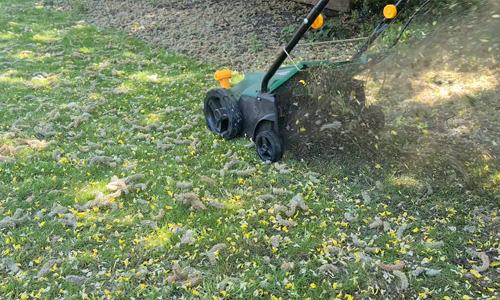
3. Remove weeds (by hand if possible)
If you don’t have loads of small weeds taking over the area, then it’s definitely best to remove them by hand. Not only would you be avoiding putting pesticide into the soil but you’ll also be able to take the next steps sooner.
If you have lots of weeds and don’t want to remove them by hand, here’s the good news AND the bad news
You can apply a weed and feed product which will start working to remove the weeds and help the grass grow.
BUT if you do apply a weed and feed product,. you will need to wait 6 weeks before you crack on with the overseeding. This may or may not be a problem for you depending when you plan to overseed.
Don’t get me wrong I have applied weed and feed products before and just coped with having a bad lawn for a longer space of time than I would have liked but it did help remove the weeds and finished off the moss.
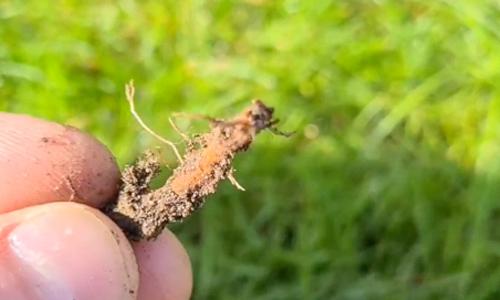
4. Aerate the soil
It doesn’t matter whether you use a weed killing product or remove weeds by hand, you can still crack on with your aerating.
I know I’m repeating myself but I’ve written a full post on how and when to aerate your lawn which you should definitely read if you have time.
Note, this is an optional step when overseeding. If you’re happy with the structure of your soil and you don’t think it’s too dense or drainage is good, then by all means skip this step.
But, if you can at least go over the lawn with a standard pitchfork, it will provide better drainage during the bad weather and help prevent moss.
5. Apply Spring Lawn Feed
Our Signature Spring Lawn Feed will give the current grass that’s already there a massive boost, while helping the new seed germinate faster
Alternatively, if you have less than 50% of good grass remaining, then I’d suggest using one of our our pre-seed fertilisers (high in phosphate). A must-use product when sowing grass seed. Especially if your lawn is sparse or you’re seeding from scratch – using a pre-seed lawn feed or our Signature Spring Lawn feed will massively increase your chances of success.
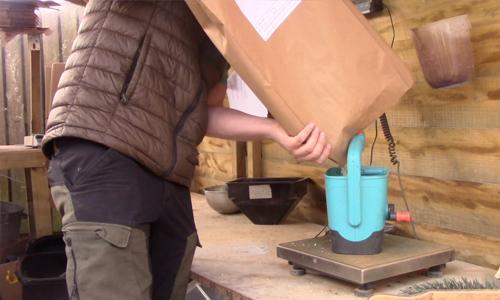
6. Sow grass seed (and pre-seed fertiliser) at a reduced overseeding rate (after scarifying & after aerating)
When sowing grass seed you need to sow at a lower rate than when you’re seeding from scratch. Our grass seed has a recommended rate of 20-25g per m2. But if you just tell us your lawn size, we’ll send you the correct amount, saving you time with too many calculations.
Personally I’d say even if you have patches, you should overseed those again the following Spring (if overseeding in Autumn) or Autumn (if overseeding in Spring)
Choose the grass seed that matches your needs. For example, we sell premium shade grass seed for shady lawns, hard wearing grass seed for lawns that get a lot of usage and finest 100% fescue grass seed that’s gives the WOW factor.
7. Apply a top dressing after seeding (optional)
There are a few benefits to using top dressing on your lawn in the Spring or Autumn- here they are:
- Level out any holes and uneven sections (I have squirrels who love digging into my lawn – soooo annoying)
- Improve soil to seed contact when you overseed the lawn meaning you have higher success of germination rate
- Improve drainage especially if you use a 70/30 sand to soil ratio top dressing.
A full explanation on how to top dress your lawn is ‘out of bounds’ for this article but there are a few basic things to know.
I recommend top dressing AFTER seeding. That’s how you’ll achieve the best seed to soil contact.
You should apply a top dressing at either 2kg per m2 or 4kg per m2, depending how uneven your lawn is or how bad the drainage is. It may also depend on budget. You could do 2kg per m2 for this overseed, then another 2kg per m2 later in the year or early the following year.
Measure your lawn into segments, for example 6m2 for each segment. Weigh out the correct amount of top dressing.
Sprinkle the top dressing within the measured out area and sweep or rake evenly into the current soil bed.
Try to do the top dressing on a dry day as it will move around the lawn better and fill in any uneven parts.
8. Keep watering for 2 weeks
Oh the watering! You don’t want all your hard work to go to waste just because you sow your seeds and think you can then just watch them grow.
It’s definitely no the case, Well, not quite anyway. If you’re sowing in late Spring it’s likely to be dry – in fact it’s impossible to say isn’t it with our Great British weather.
If it is dry, I’d say to water your seeds for approx 5 minutes per day. If you need to move your sprinkler round the garden to get the whole lot, then simply do it in each spot for five minutes.
Do this twice every day for 2 weeks.
Another tip?
I recommend watering in the morning or evening. Or at leas in the evening – cos the ground will stay moist because the air temperature cools down over night.
9. Add the finishing touches – STRIPES
Please tell me the reason you want to overseed is to get some beautiful stripes in your grass. Well the final trick to achieving those stripes is soo simple it’s untrue.
ALl you need is a rear-roller lawn mower, thne mow up and down the lawn to and from the direction in which you look at the grass.
That way you’ll be able to admire your work from wherever your are.
How to overseed a large lawn
The process for overseeding a large area is the sameas a small area. the only thing that’s different is the tools you use. If the area you’re working with is over 200 m2 then you’ll definitely want to use mostly machinery to achieve the above jobs.
When it comes to spreading either feed, fertiliser or seed, you’ll need to consider a spreader with wheels or a mid-sized hand spreader. That way. you’ll be able to make it so much more efficient – Booyaah!



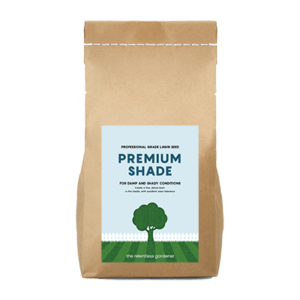

This Post Has 26 Comments
Hi Matt
I have an 18 month old (turfed) lawn. Weeds and moss aren’t that much of an issue, but the grass quality and appearance isn’t what I’d hoped, in particular with the amount of rye grass. Based on your articles I plan to scarify only with an electric lawnrake, then aerate and use your pre-seed fertiliser, finest fescue seed and 70/30 top dressing over the next few weeks. Does this sound a good approach based on current lawn status?
Hi Andy, Yeah that sounds like the perfect approach. However if there’s more than 50% of current grass that’s revivable after scarifying I’d recommend using our Premium Autumn Feed instead.
Thanks Matt, I’ve now received the Premium Autumn Feed you suggested. Once this has been applied, is there a minimum waiting time before overseeding/top dressing?
Hi Andy, there’s no minimum time between feeding and overseeding as the feed is designed to help both the current grass and new seed – hope that helps. Cheers, Matt
Hi,
I have just applied moss kill, within next two weeks I will cut low then scarify. My plan is then to hollow tine and then overseed. Ideally, after overseeding, I would like to apply a top dressing. My lawn is 100 square meters and at 2kg per square meter thats a lot of top dressing. Do you supply and if so what would be the cost. By the way, I live in Northumberland.
We only sell base sand for lawns atm. Pricing can be calculated here100% Organic Base Sand for Levelling & Dressing Lawns
Hi Matt, thanks for providing all I need to tackle my lawn troubles! The graphic at the top of the article mentions mowing on the lowest setting, but you don’t list that in the steps, is this something to be done after aerating? Also, the top dressing rate differs: 1-2kg/m2 in the graphic, but 2-4kg/m2 in step 7, which is correct? Thanks.
Technically you can apply anything between 1-4kg per m2. So it depends on how much levelling you need to do. Just for seed-soil contact 1-2kg will suffice.
Matt – are there any spreaders you recommend?
Hi Giles, What size area are you covering mate? Cheers, Matt
Hi Matt I’ve got a lot of weeded grass I verticut airation how do we get rid of it I’ve had the best seed mix you can get bents and fescues root zone to top dress would you spray gallop 360 before I top dress
Hi Lee, I always recommend removing weeds by hand where possible and then drowning them out with regular overseeding of fine grass mixes (e.g. any of ours). However, if you do want to apply a weed killer, you’ll need to wait at least 6 weeks before overseeding. Hope that help. Cheers,
Matt
Hi Matt
I’ve just applied a wetting agent to all my lawns & watered in as per instructions on the bottle.
How long will it last / when will I have to re apply.
Hi John,
You should be okay for wetting agent now until next year. I usually recommend applying it just after Spring when there’s likely to be a dry spell. Hope that helps
If I have already good quality top soil in plenty of supply, and I have applied your pre-seed fertiliser, could I apply a thin layer on top of the seed instead of sand?
Yeah this is a good idea as it will help cover the seed from the birds too.
How long should you wait between applying Iron Sulphate and overseeding?
I applied Iron Sulphate in liquid form 7 days before overseeding and it has now been 2 weeks since overseeding and there is no sign of germination. It could just be that weather conditions haven’t been favourable for germination, or could it be that the Iron Sulphate has affected germination?
I’d wait one week before scarifying then once you’ve scarified, you can seed straight away. The nights have been very cold but the temps are warming so I’d give it a little longer.
Hi Matt, you recommend a 30/70 top dressing after over-seeding. Can you please explain more about what that dressing is comprised of?
Hi Colin,
While not essential, a top dressing of 70/30 will help with drainage and germination speed due to seed-to-soil contact. It comprises of 70% sports sand and 30% loam.
Cheers,
Matt
Hi Matt.
I’ve overseeded our lawns with your seed for shady and damp areas a couple of weeks ago. The seeds are just beginning to sprout in a few places. How soon can I apply an Autumn/Winter feed?
Hi Richard,
You can apply our Premium Autumn Feed or 100% Organic Autumn/Winter straight away. However, it depends if you applied a pre seed fertiliser when sowing the seed, if so, you’ll need to wait around 10 weeks before feeding it again. In terms of our Specialist Winter Lawn Feed, I’d recommend an autumn feed first, then wait until Dec/January now to apply it. Hope that helps, cheers, Matt
Pingback: How, why & when to sow grass seed - Lawn Feed & Fertiliser
Great reading, thanks for the advice
Hi Matt.
How soon after applying liquid ferrous sulphate for moss killing, are you able to use pre seed fertiliser.
Hi Chris,
Technically, you can apply pre seed fertiliser straight away but you might want to wait a few days then scarify any dead moss out before applying.